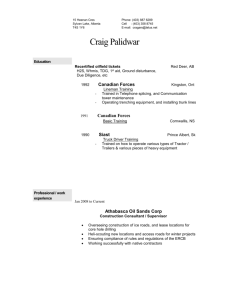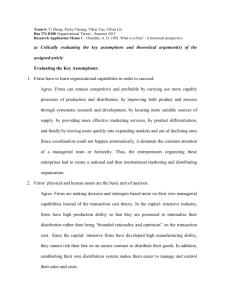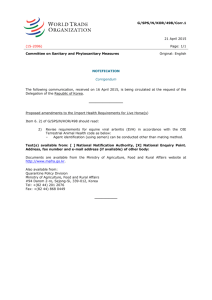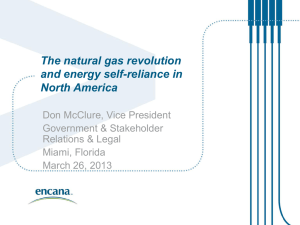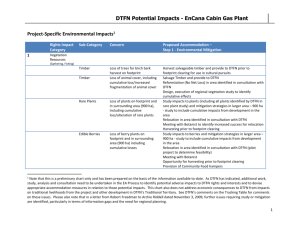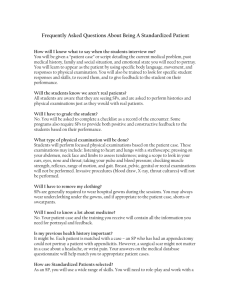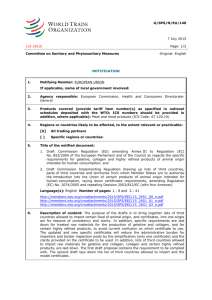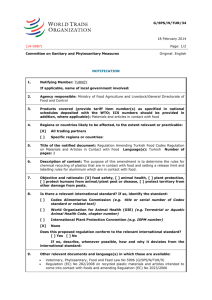On-site service provider EH&S expectations
advertisement
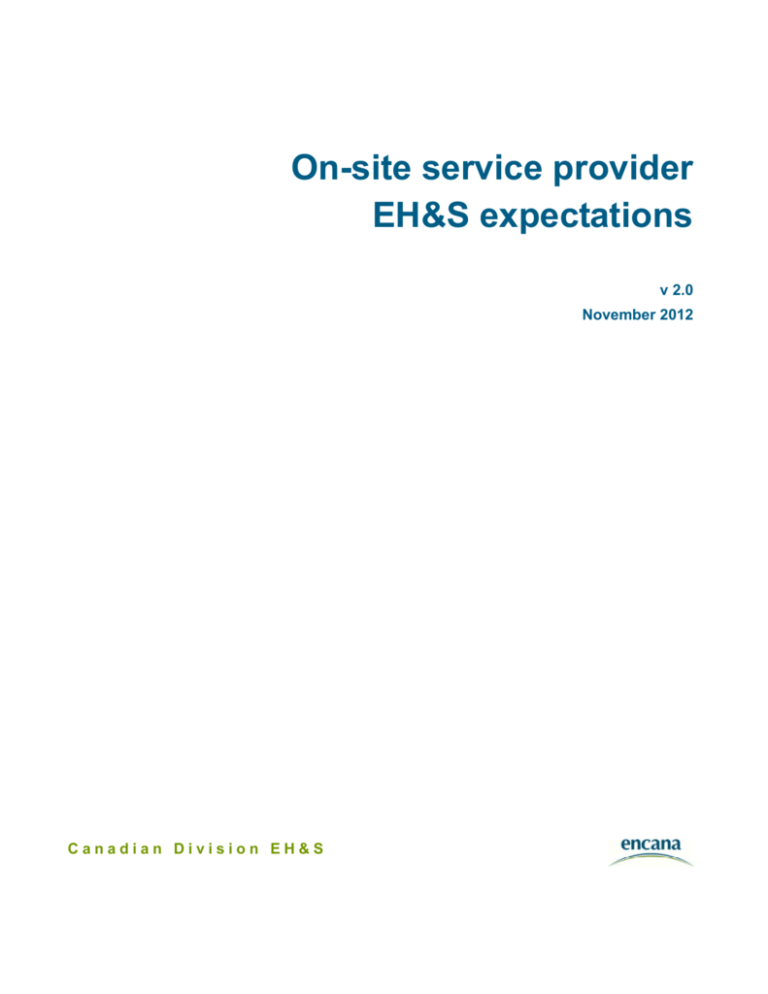
On-site service provider EH&S expectations v 2.0 November 2012 Canadian Division EH&S Revision history Revision Author Approver Date revised v 1.0 September 2011 B. Anderson v 1.0 September 2011 D.W. Smith D.W. Smith May 1, 2012 D.W. Smith M. Sunstrum November 15, 2012 V 2.0 November 2012 Comments Formatted Specified “offshore operations” in Preface (Page 1) Updated to reference: Added content pertaining to ISN (Contractor Management) Revised content to the Emergency Response section New content for Hot Work Revised Safety Training requirements Table of contents Preface ...................................................................................................................................................................... 1 Regulatory disclaimer and industry recommended practices .................................................................................... 1 Contractual obligations / Contractor Management .................................................................................................... 1 Safety training and orientations .............................................................................................................................. 2-3 Courtesy matters ....................................................................................................................................................... 3 Certificate of recognition/Small employer certificate of recognition requirements .................................................... 3 Security and social media .......................................................................................................................................... 3 Safety permits ............................................................................................................................................................ 4 SPs using subcontractors .......................................................................................................................................... 4 Personal protective equipment ............................................................................................................................... 4-5 Emergency preparation and response ...................................................................................................................... 5 Media relations .......................................................................................................................................................... 6 Incident management ................................................................................................................................................ 6 Fit for work ................................................................................................................................................................. 6 Alcohol and drugs ...................................................................................................................................................... 7 Hazard and risk management ................................................................................................................................... 7 Fire and explosion hazards ....................................................................................................................................... 9 Hot work ..................................................................................................................................................................... 9 Purging .................................................................................................................................................................... 10 Flammable liquid loading/offloading ........................................................................................................................ 10 Energy isolation ....................................................................................................................................................... 11 Ground disturbance ................................................................................................................................................. 11 Trenching and shoring ............................................................................................................................................. 11 Confined space ................................................................................................................................................... 11-12 Journey management .............................................................................................................................................. 12 Motor vehicle ........................................................................................................................................................... 12 Off-highway vehicle ................................................................................................................................................. 13 Rental lease equipment ........................................................................................................................................... 13 Working alone .......................................................................................................................................................... 13 Working at heights ................................................................................................................................................... 13 Working at night ....................................................................................................................................................... 14 Camp rules .............................................................................................................................................................. 14 Environment........................................................................................................................................................ 15-16 Acronyms ................................................................................................................................................................. 16 This page intentionally left blank. Canadian Division On-site service provider EH&S expectations Preface Encana defines a Service Provider (SP) as a company that performs a service without specifying the individuals who provide the service. Further, an on-site SP is present at an Encana field worksite to perform work. This document informs on-site SPs working for Encana’s Canadian Division of Encana's environment, health, and safety (EH&S) expectations. It is the SP’s responsibility to incorporate these expectations into their operations when working for Encana. Note: This document does not apply to offshore activities and offshore operations. In addition, companies working for the Encana Geophysical Acquisitions Services (GAS) must refer to the Encana Geophysical EHS Guidelines, which outlines specific requirements for geophysical general contractors. The provisions of this document to the SP does not relieve the SP the obligation to make a full assessment of all risks associated with its activities on Encana worksites and to observe all necessary requirements to ensure a safe and environmentally sound operation. The most current version of this document is available publicly on the Encana website (www.encana.com) under Contractor connection, Expectations & practices, Canada. Regulatory disclaimer and industry recommended practices The SP has the responsibility to comply with all applicable laws, statutes or other regulatory requirements and industry best practices. If there is a conflict between these stated expectations on the one hand, and the statutory and regulatory requirements on the other hand, the legal statutory and regulatory requirements shall supersede this document. SPs shall strictly comply with all Encana policies and practices located on www.encana.com under Contractor connection and such other policies and practices as identified by Encana to the SP, as well as the expectations stated in this document. The words in these documents are to be read in their entire context. In the event of an irreconcilable inconsistency among these documents, the more specific/strict requirements shall override the other requirements. Encana endorses the Industry Recommended Practices (IRPs) published by Enform. The IRPs are publically available on the Enform website (http://www.enform.ca/safety_resources/IRP.aspx). SPs are expected to comply with Enform IRPs and ensure personnel are trained in IRPs applicable to work on Encana field worksites and specific to each job. Contractual obligations This document summarizes EH&S expectations for field worksite (i.e., on-site) SPs. Additional requirements may exist in Service Orders, Master Service and Supply Agreements, master contracts or other agreements. Contractor Management (ISNetworld) Worksite service providers must obtain and maintain an acceptable grade in ISNetworld (i.e., A, B or C) to prequalify and maintain their status as an acceptable vendor. LL ID#: 170608723 November 2012 V2.0 Page 1 Canadian Division On-site service provider EH&S expectations Safety training and orientations On-site SP personnel are expected to complete the following training prior to their arrival on Encana field worksites. Note: Proof of training may be requested by Encana. All workers on an Encana field worksite Encana's General Safety Orientation for Service Providers Industry Safety Orientation (e.g. Enform’s General Safety Orientation (eGSO), PST, CSTS) H2S Alive® WHMIS First Aid (Standard First Aid – Alberta / OFA Level 1 – B.C.) Bear Awareness Task Specific Training Detection and Control of Flammable Substances (Enform or Accepted Equivalent Training) when required to use gas detection equipment Ground Disturbance training as required TDG training for workers that coordinate the shipping of, the handling, and transportation of dangerous goods Workers operating a motor vehicle require documented training, which measures driving skills and knowledge beyond jurisdictional licensing requirements. In British Columbia, on remote sites with six or more people without a Level 3 or equivalent First Aid attendant immediately available, at least one person must possess the BC First Aid Transportation Endorsement. Workers involved in down-hole operations or operation of associated surface equipment require training as outlined in IRP 18: Fire and Explosion Hazard Management. Additional task specific training for Service Providers may be required as stated by Federal and/or Provincial Regulation, or may be identified as a requirement for the specific business or discipline. Examples of task specific training may include: Mobile Equipment operation, Fall Protection, Confined Space Entry/Rescue, Wildlife Awareness, etc. Note: Encana may implement “site specific” training requirements and/or exceptions if required (e.g. mandatory training required for the worksite or exceptions to minimum required training for service providers based on a project specific risk assessment performed by the business) LL ID#: 170608723 November 2012 V2.0 Page 2 Canadian Division On-site service provider EH&S expectations Site-specific orientation Workers and visitors entering an Encana field worksite for the first time must receive a site-specific orientation. Individuals who have not received a site-specific orientation must request an orientation from the Encana site representative. SPs on Encana field worksites without an Encana site representative must ensure all workers/visitors receive a site-specific orientation. The site-specific orientation must include an overview of site-specific hazards, emergency response plan (ERP) information and site reporting requirements. If site conditions change or new hazards are identified, individuals must have the site-specific orientation updated before entering the site. Ground disturbance orientation All SP personnel involved in ground disturbance activities on Encana field worksites must complete the Encana Ground Disturbance Orientation. New and young worker (short-service employee) orientation All SPs must have their own new worker orientation and training program. Medical provider orientation All medical SPs must complete the Encana Medic Orientation prior to arriving onsite All medical SPs must be aware of any controlled products on the Encana field worksite (i.e., as identified on material safety data sheets [MSDS]) and appropriate First Aid treatment/facilities for controlled products. Courtesy matters SPs are expected to understand and model the actions and behaviours as described in Encana’s Courtesy Matters documentation, available at: http://www.encana.com/business/contractors/courtesy-matters.html Certificate of Recognition/Small Employer Certificate of Recognition requirements This certification is strongly recommended for all SPs and is recognized within Encana’s ISNetworld prequalification grading. Specific work groups within Encana may require a Certificate of Recognition (COR)/Small Employer Certificate of Recognition (SECOR) to work for Encana. Security and social media SPs working with Encana are expected to behave in a manner that promotes sound security practices. SPs must adhere to Encana’s Corporate Responsibility Policy. Criminal behaviour in any form will not be tolerated nor will the condoning of illegal acts by others. Firearms and ammunition are not permitted on any Encana location unless explicit authorization has been received from the Encana site representative. SP personnel must not collect, distribute, publish, post or otherwise disseminate any information, document, photos, videos, text and audio obtained while working at an Encana field worksite without prior approval by Encana. If in doubt, consult with the Encana site representative or contact Encana’s designated social media spokesperson (social.media@encana.com). LL ID#: 170608723 November 2012 V2.0 Page 3 Canadian Division On-site service provider EH&S expectations Safety permits Encana has a safety permit system. SPs working on Encana sites must adhere to the Encana work permitting system in place as communicated to them by the Encana site representative. Service Providers using subcontractors SPs employing subcontractors are expected to follow the subcontractor management protocol as identified in their ISNetworld profile. Requirements include: verification of valid WCB coverage a review of subcontractor safety statistics a review of the subcontractors safety program orientation of subcontractors to the SP’s management system orientation to this document The SP must report all subcontractors’ incidents as their own (see Incident Management). Personal protective equipment In addition to the requirements below, SPs must provide SP personnel with personal protective equipment (PPE) suitable to any identified chemical, physical, biological or ergonomic hazard (see Hazard and Risk Management). Note: Encana may allow exceptions to the SP’s PPE requirements on a project-specific basis. Fire retardant clothing Personnel working on Encana field worksites must wear fire-retardant clothing consisting of Nomex IIIA full body coverage or equivalent with reflective strips. If rainwear is worn, it must be fire retardant and have reflective strips. Clothing worn beneath fire retardant wear must be either fire retardant or 100 percent cotton. Hard hats Personnel working on Encana field worksites must wear hard hats. Minimum requirements include: Type I impact and Class E electrical. SPs may require the additional protection of side impact hardhats based upon a risk assessment of their work activities and environment. Safety footwear Personnel working on Encana field worksites must wear footwear that: – is oil, acid, and puncture resistant – extends up the leg a minimum of six inches and must be properly tied and fastened – bears the following visible Canadian Standards Association (CSA) certification markings: CSA green triangle for puncture protection (Figure 1) CSA white rectangle with the orange Greek letter omega for electric shock resistance (Figure 2) Figure 1. CSA Green Triangle Figure 2. CSA White Rectangle SPs may require additional safety footwear protection based on their risk assessment of their work activities and environment. LL ID#: 170608723 November 2012 V2.0 Page 4 Canadian Division On-site service provider EH&S expectations Safety eyewear Personnel working on Encana field worksites must wear CSA-approved protective eyewear. For those requiring prescription eyewear, safety eyewear can be worn overtop prescriptive eyewear if prescription safety eyewear is not available. Hearing protection SP personnel working on Encana field worksites must wear hearing protection according to the noise levels listed: Noise level (dBA Lex for an 8-hour shift) CSA Class of hearing protection 85-90 A, B or C 90-95 A or B 95-100 A 100-105 A 105-110 A type earplug + A or B type earmuff >110 A type earplug + A or B type earmuff and limit exposure time to achieve <85 dBA Lex Note: Double hearing protection must not be worn in areas with noise less than 95 dBA due to the potential for sensory isolation and the inability to hear emergency alarms. Respiratory protection When the use of supplied air breathing apparatus (SABA) or self-contained breathing apparatus (SCBA) is required: a person acting as a safety watch must be readily available when SABA or SCBA is being used half face masks are required as a minimum when MSDS sheets identify them as an appropriate level of protection, or when directed by the Encana site representative facial hair that interferes with the seal of the respirator is not permitted Emergency preparation and response Emergency response plans SPs are expected to follow any Encana site-specific Site Safety Plans and/or Emergency Response Plans when requested. Although development and communication of the Encana Site Safety Plan is the responsibility of the Encana Worksite Supervisor, SP's are required to ensure that the contents of the Site Safety Plan are effectively communicated to all workers. In addition, SPs are expected to have their company specific emergency response plan (ERP), available at the worksite, with appropriate contact information and emergency procedures. SP personnel are expected to participate in any tabletop exercises or drills held on Encana worksites. LL ID#: 170608723 November 2012 V2.0 Page 5 Canadian Division On-site service provider EH&S expectations STARS registration Encana field worksites and activities are typically registered with the STARS Emergency Link Centre (ELC). When an Encana site representative is not on the field worksite, then SPs must register the site as an Encana site with the STARS ELC at 1-888-888-4567 prior to operations. The STARS site registration number and the STARS ELC number must be posted at the field worksite. Upon completion of work, Encana field worksites are de-registered with STARS by Encana. When an Encana site representative is not on the field worksite, SPs must de-register the site with the STARS ELC at 1-888-888-4567. Media relations All public media inquiries must be directed to the Encana site representative. Incident management SPs must have incident investigation procedures. Encana’s incident management practice and any associated procedures take precedence. Encana defines an incident, which includes near hits, as an undesired or unplanned event or non-conformance that has resulted in, or could result in, personal harm, property damage, detrimental environmental impact or loss of production. All personnel present on site at the time of the incident, excluding those being transported or transporting people for medical treatment, must remain in a safe location on site until directed otherwise by Encana to aid in the investigation. For incidents occurring on an Encana field worksite, SPs are expected to complete and submit incident investigation reports. The initial report should be submitted to the site representative within 24 hours, or prior to leaving site, whichever is sooner. To facilitate incident reporting, workers should have incident reporting documentation readily available in the field. Incidents that require mandatory reporting to a regulator must be communicated in coordination with Encana. Any written or verbal requests from regulatory authorities related to Encana activities must be immediately reported to Encana. Fit for work SPs are expected to: develop and enforce fit-for-work practices and engage resources to support fit-for-work as appropriate ensure staff are fit-for-work and remain so: – when scheduled on-call for Encana – when on Encana premises – during all business activities undertaken in the course of Encana’s operations, whether conducted on or off company premises SP personnel are considered unfit for work if injury, fatigue, illness, physical or psychological health issues or the use of alcohol or drugs results in or could result in a reduced ability to perform assigned duties and responsibilities safely or effectively. LL ID#: 170608723 November 2012 V2.0 Page 6 Canadian Division On-site service provider EH&S expectations Alcohol and drugs SPs are required to meet the standards outlined in Encana’s Alcohol & Drug Policy. Depending on the terms of their agreement with Encana, SPs must either: implement an alcohol and drug policy and testing program that meets the same standards for prevention and testing as Encana’s program follow the requirements outlined in Encana’s Alcohol & Drug Policy SPs are responsible for enforcing the requirements of their alcohol and drug program among their employees, subcontractors and personnel who do business or who work on Encana premises. For details on SP responsibilities refer to the Contractor Compliance with the Alcohol & Drug Policy. SPs must conduct their own post-incident and probable cause testing in accordance with their company policies/practices. Encana may request post-incident and/or reasonable cause alcohol and drug testing at its sole discretion. Workers directly involved in post-incident and probable cause testing must not return to work for Encana until SP personnel have been confirmed fit for work. On-site drug and alcohol inspections Contracts with Encana authorize unannounced searches for and seizure of alcohol, drugs or drug paraphernalia during on-site activities when there are reasonable and probable grounds. Searches may be random and include vehicles, buildings, accommodation or other structures. Hazard and risk management Encana expects SPs to have a hazard and risk management program that addresses any and all chemical, physical, biological and ergonomic hazards on Encana field worksites. SP personnel should be trained in hazard and risk management and made aware of their obligation to stop work if the hazards identified pose an immediate threat. SP management is expected to conduct regular field worksite inspections. Chemical hazards Encana expects SPs to address chemical hazards in their hazard and risk management program. SPs must address any chemical hazards related to their services provided to Encana. All controlled products brought onto an Encana field worksite must be properly labeled and accompanied by upto-date MSDS. Controlled products and hazardous wastes must be stored in a manner or location to minimize risk. All containers, piping, vessels, and tanks must be labeled to identify their contents and be specific enough that the corresponding MSDS can be determined. The following potentially hazardous products may be present on an Encana field worksite: sour gas (H2S) sweet gas benzene methanol glycol silica petroleum-based drilling fluids LL ID#: 170608723 November 2012 V2.0 Page 7 Canadian Division On-site service provider EH&S expectations Encana will provide Material Safety Data Sheets (MSDS) upon request for all controlled products on Encana field worksites including Encana produced products (e.g., sour gas, sweet gas, and produced water). SPs are expected to have combustible gas detection on all Encana field worksites where a fire and explosion risk may exist (e.g., a live site where gas is present). SPs are also required to have H2S detection on Encana field worksites via personal or fixed monitors where concentrations are equal to or greater than 0.1 percent or when an unacceptable exposure risk exists. These risks are best mitigated through use of a three- or four-head gas monitor. Gas detection monitors must be calibrated, maintained, and used in accordance with manufacturer recommendations. Personal monitors shall be bump tested daily prior to use and results recorded in a log. Biological hazards Encana expects SPs to address biological hazards in their hazard and risk management program. The SP’s biological hazard program must consider, at a minimum, any: blood-borne pathogens airborne pathogens mould spores bacteria (e.g., food handling) potable water insect and animal related diseases and events Physical health hazards Encana expects SPs to address the physical hazards discussed below in their hazard and risk management program. Noise On SP buildings or equipment with noise levels greater than 85 dBA permanent signage warning of the noise hazard must be posted. When noise levels exceed 105 dBA permanent signage indicating double hearing protection (muff and plug) must be posted. SP personnel exposed to noise levels greater than 85 dBA must properly and consistently use hearing PPE (see Hearing Protection). All SPs must have an audiometric program for noise-exposed workers that meets or exceeds the minimum legislative requirements for the jurisdiction in which they are working. Naturally occurring radioactive material SPs should be aware that Encana field worksites may contain Naturally Occurring Radioactive Material (NORM). Where NORM has been confirmed, or NORM hazards have been identified, Encana will provide site-specific procedures and signage. LL ID#: 170608723 November 2012 V2.0 Page 8 Canadian Division On-site service provider EH&S expectations Cold stress Non-emergency outdoor work must cease when air temperatures reach the levels shown in Table 2. Outdoor work is considered work that does not offer immediate access to a heated shelter or equipment (e.g., heated cab). Table 2: Non-emergency work must cease Wind speed/description (km/h) Air temperature No wind -43°C 8 (wind sock moves) -40°C 16 (wind sock fully extended) -38°C 24 (raises newspaper page) -35°C 32 (blowing and drifting snow) -32°C Ergonomic hazards Encana expects SPs to address ergonomic hazards in their hazard and risk management program. Fire and explosion hazards Fire and explosion hazard management (FEHM) SPs conducting down-hole drilling activities such as coiled tubing, pumping hydrocarbons, snubbing, swabbing, fracking, well testing and flowing are required to implement a FEHM program as outlined in IRP 18: Fire and Explosion Hazard Management. Hot Work SPs must have their own hot work practice and procedures that meet or exceed all regulatory requirements and Encana expectations Where there is a potential for fire and explosion SP’s are required to follow all Encana permitting processes for hot work as well as ensure that all non-intrinsically safe equipment such as cameras, cell phones, tablets, and laptops are left in vehicles/offices/trailers. LL ID#: 170608723 November 2012 V2.0 Page 9 Canadian Division On-site service provider EH&S expectations Purging Purging must be done prior to the execution of repair, modification, inspection or entry of any process equipment that has or may have contained a toxic, flammable or corrosive material. All vessels tanks, equipment, piping and pipelines should be purged of air prior to pressuring up or placing back into hydrocarbon service. Similarly they should be purged of combustibles (hydrocarbon liquids or vapours) prior to opening up for ventilation, inspection, construction or maintenance. Combustible liquids will continue to flash-off vapours after purging; therefore, controls must be in place where there is a possibility of accumulation. Flammable liquid loading/offloading SPs must follow Encana site-specific requirements for flammable liquid loading/offloading. In addition to site-specific requirements SPs involved with flammable liquid loading/offloading must adhere to the following expectations. Smoking or other sources of open flame are not permitted within 25 metres of the loading/offloading operation. Any other sources of ignition must be a minimum of 8 metres from the area involved in loading/offloading flammable liquids. At a minimum the wheels of the truck and/or trailer loading/offloading flammable liquids must be safely chocked against forward and backwards motion. Hoses and fittings used for loading/offloading flammable liquids must be rated for the product being transferred. Grounding cables must be utilized at all times when loading/offloading flammable liquids and must remain effectively attached until all other connections are removed. Both tanks and tank trucks must be bonded and grounded. The connector attachment sites should be non-painted, rust-free surfaces. Servicing and maintenance must not be carried out on a tank truck when loading/offloading flammable liquids. A worker’s sole duty during loading/offloading of flammable liquids must be to monitor and operate loading/offloading equipment. This worker must remain in the immediate area and must be able to promptly shut off equipment if required. Nozzles must not be blocked open, except with a device designed and approved for the task by a manufacturer. When possible, all vehicles involved in loading/offloading flammable liquids must be shut off prior to transfer beginning. If a tank is pressurized as part of the offloading process, the truck must be fitted with a pressure relief valve, a regulator, a pressure gauge and a mechanism for quickly shutting off supply to the tank. The controls must be readily accessible to the operator. When loading/offloading flammable liquids, all vent lines and hoses required by the manufacturer and legislation must be in place. The outlet of these must be in an area that does not impact workers in case of a release, and has no risk of explosion on an Encana site. Cam locks utilized for connecting hoses must have a means of secondary securement, such as cable ties or strapping. Prior to loading/offloading flammable liquids, connections must be checked and verified to ensure no leaks. All spills, regardless of size or material, must be immediately reported to the Encana site representative. The atmosphere around the tank truck must be tested and continuously monitored for lower explosive limit (LEL) and toxicity during loading/offloading. LL ID#: 170608723 November 2012 V2.0 Page 10 Canadian Division On-site service provider EH&S expectations Energy isolation SPs must follow Encana site-specific procedures for the safe isolation of energy in production processes, facilities, and equipment using blanks, blinds, locks and tags. For their own equipment and processes, SPs are expected to implement their own energy isolation procedures for all potentially harmful energy sources. Ground disturbance For ground disturbance activities, SPs must follow IRP 17: Ground Disturbance and Damage Prevention and any requirements outlined in Encana’s Ground Disturbance Orientation (see Ground Disturbance Orientation). SPs must ensure at least one individual (Encana staff or SP personnel) with a valid Ground Disturbance Supervisor Training Certification or jurisdiction-specific equivalent certification is at the immediate site of the ground disturbance at all times during the ground disturbance activity. SPs must ensure a properly completed Ground Disturbance Checklist and any required Encana permits are in place prior to the initiation of ground disturbance activities. SPs must immediately report any mechanical contact with an underground facility to the Encana site representative and/or the owner of the facility, if it is not Encana. Trenching and shoring All SP personnel involved with trenching must receive Encana’s Ground Disturbance Orientation (see Ground Disturbance Orientation) prior to trenching or shoring. Those involved with shoring or entry into the trench following shoring must be versed in the regulatory requirements around trenching and shoring. Confined space SPs must make every effort to use zero entry tools, equipment, and procedures to avoid the worker exposure hazards of confined space entry. SPs must make every effort to reduce hazardous atmospheres prior to opening any manways, access hatches, etc. This can be achieved by using tools/procedures such as flooding/spray tools, vacuum trucks, H2S scavengers and chemical additives. SPs involved in confined space entry must have their own confined space code of practice that meets or exceeds all regulatory requirements. It is critical that SPs understand that confined space requirements differ provincially; therefore, the SP is responsible to incorporate relevant regulation into their own confined space code of practice. At all field worksites Encana requires identification of all confined spaces. Additionally, Encana expects SPs to adhere to the following. Prior to a worker entering a confined space, competent workers must document the hazard assessment of the work area that identifies the hazards that a worker is likely to be exposed to while in the confined space, and the controls required to eliminate or mitigate the identified hazards. Atmospheric testing must be completed no more than 20 minutes prior to any entry into a confined space. Documentation of testing must be posted at the entry point. Work is not permitted in spaces where the flammable limit exceeds 20 percent LEL. During confined space work continuous mechanical ventilation must be maintained. LL ID#: 170608723 November 2012 V2.0 Page 11 Canadian Division On-site service provider EH&S expectations Confined space permits A permit is always required for entry into a confined space. This may be an Encana permit or an SP permit depending on the site circumstances. If there is any doubt, contact the Encana site representative. A permit in itself is not sufficient to meet regulatory requirements and may need to be accompanied by additional documentation (e.g., hazard assessments, personnel logs, atmospheric monitoring sheets, energy isolation checklists and confined space entry checklists). SPs are required to use these additional documents. Any permit used for confined space must include at a minimum: name of the confined space activities to be performed names of workers allowed entry required precautions for the space time and expiration of the permit a record of atmospheric testing with any specific numerical atmospheric findings Journey management SPs are encouraged to develop a risk-based journey management program. In support of a journey management program, SPs should contact their Encana site representative regarding issues impacting Encana sites and site access (e.g., power lines, road channels, weight restrictions, road conditions and wildlife hazards). Radio-controlled roads SPs must ensure vehicles travelling on radio-controlled roads have a functioning two-way radio. Correct road frequencies must be installed in the radio. Local road protocols must be followed. Motor vehicle SPs are expected to use hand signals as outlined in IRP 12: Hand Signals for Directing Vehicles. In addition, SPs are expected to observe the following. On Encana sites and roadways, the use of cell phones and other electronic devices is prohibited in motor vehicles while the vehicle is in motion. This includes the use of hands-free devices. SPs should have a driver distraction practice regarding the use of cell phones and other electronic devices while driving and follow provincial regulations. Pull-through/drive-through or back-in parking is preferred at all locations. If backing in a vehicle is required, use a spotter when possible. Use preferred road routes and drive in accordance with Encana’s Courtesy Matters program. The use of electronic communication devices while refuelling is prohibited. Before starting the vehicle, drivers should walk around the vehicle to check for possible obstructions or unfavourable conditions. All loads must be properly placed and secured. LL ID#: 170608723 November 2012 V2.0 Page 12 Canadian Division On-site service provider EH&S expectations Off-highway vehicles Off-highway vehicles include, but are not limited to: all-terrain vehicles (ATV’s), commonly referred to as quads snowmobiles argos side-by-sides (UTV’s) SPs must follow the manufacturer’s instructions for operation of the off-highway vehicle. Prior to working for Encana all SP personnel using off-highway vehicles must be trained in correct operation of the vehicle and wear appropriate PPE. Off-highway vehicles must not approach or park within 7.5 metres of any wellhead, piping, process vessel or tank containing combustible fluid or gases without prior issue of a Hot Work Permit. Operators and passenger of off-highway vehicles must wear CSA- or Department of Transportation (DOT)approved helmets while the vehicle is in motion. Rental lease equipment The following requirements apply when an SP is renting or leasing equipment: The equipment must be: safe for use and meet legislative and any other legal requirements provided with maintenance and operation manuals operated by competent operators who employ the proper PPE Note. If any requirements listed above are not met, Encana may at its sole discretion refuse entry of rental lease equipment to the Encana field worksite. SPs providing rented or leased human occupancy shacks, wellsite trailers or camps must have the following as part of their safety features: carbon monoxide detectors propane detectors fire/smoke detectors Any rented or leased equipment that can or does produce electricity or a static charge must be bonded and grounded as per manufacturer’s specification. Working alone SPs are expected to develop and implement a system to monitor the location of its workers and to ensure their well-being in working alone situations. SPs must ensure their workers are competent in SP working alone procedures and any associated equipment. Working at heights SPs must use or wear fall protection equipment at temporary or permanent installations, if a worker could fall: more than 3 metres less than 3 metres, when there is a possibility that a worker could sustain injuries more serious than those likely to result from landing on a solid, flat surface (e.g., over moving or rotating equipment, open water or tanks, ice or heated surfaces) more than 1.2 metres, but less than 3 metres, in the case of a permanent installation where guardrails or other similar means of fall restraint have not been provided LL ID#: 170608723 November 2012 V2.0 Page 13 Canadian Division On-site service provider EH&S expectations SPs must remove a fall protection system from service when it: is defective has come into contact with excessive heat, a chemical or any other substance that may corrode or otherwise damage the fall protection system has arrested a fall If a fall protection system is removed from service, it must not be reused until it has been inspected and recertified safe for use by the manufacturer or a professional engineer. Working at night SPs working on an Encana lease at night are expected to follow the requirements of Enform's Lease Lighting Guideline. Beyond this guideline, Encana expects SPs to ensure the following. Prior to commencing the first night shift, workers should be given a minimum of 24 hours notice to help prevent fatigue. The impacts of impairment due to worker fatigue must be considered prior to and during night work. If an Encana site representative is not on site for non-routine night work, the SP must conduct a hazard assessment (including darkness-related issues). This must include a review of the potential for increased wildlife activity and reduced emergency response resources during night hours. For night work, all SP personnel must wear high visibility reflective vests or coveralls with reflective stripes. Camp rules SPs are responsible for providing their employees and subcontractors who require accommodation at an Encana camp with copies of Encana’s Camp Rules and Code of Conduct. Contact the Encana site representative for a current copy. Camp rooms are the property of Encana. Residents and visitors should have a limited expectation of privacy. Encana security or the camp manager may enter a camp room at any time for any good reason, including but not limited to ensuring camp maintenance, security, good order and safety. All SP personnel are required to register at the camp office upon arrival and must check out upon departure. Should the SP fail to check its personnel out of the camp, all costs for the days incurred until such personnel have been checked out will be charged to the SP. Where reasonable and probable grounds exist to believe that a prohibited object, property or substance is present in a resident’s room, Encana will arrange for resident’s room to be searched. From time to time, Encana may carry out or cause to be carried out random searches using dogs trained in the location and detection of alcohol, drugs, and drug paraphernalia (see On-site Alcohol and Drug Inspections). It is a privilege to be provided with accommodation at any Encana camp and such privilege may be revoked in accordance with Encana’s Camp Rules and Code of Conduct. Any violation will be subject to discipline up to and including termination of employment and/or immediate removal from the camp. LL ID#: 170608723 November 2012 V2.0 Page 14 Canadian Division On-site service provider EH&S expectations Environment SPs working on Encana sites must adhere to Encana’s environmental expectations. Pre-development environmental planning and assessments SPs must confirm that landowner permission has been obtained prior to conducting any field assessment on private land. If uncertain, contact the Encana Environmental Advisor to confirm permission has been obtained. SPs must confirm with the Encana site supervisor that proper regulatory permits are in place before beginning any activity in or about a watercourse, stream or wetland. Wildlife SPs must take all practical steps to minimize disturbance to wildlife and wildlife habitat. SP personnel must not approach, feed, intimidate or harass wildlife. Violation of this expectation may result in limited access to all Encana locations. SPs must not take, feed or otherwise harm species or their habitats or migratory birds or their nests, in accordance with provincial and federal regulations and Encana expectations. If species or their habitats or migratory birds or their nests are affected by construction activity, the SP must stop activity in the area and notify the Encana site representative. Work in the area may resume only after the Encana environmental advisor has been contacted and Encana authorizes the resumption of work. Wildlife sightings must be reported where required as part of area-specific operating requirements. In particular, wildlife observed in sensitive habitat areas such as grizzly bear range, caribou range and native prairie habitat must be reported. Contact the Encana environmental advisor for additional information regarding wildlife sighting reporting requirements and to obtain wildlife sighting cards. Wildlife sighting cards can be downloaded from the Contractor connection section of the Encana website. SPs must notify the Encana site representative of any animal in distress or deceased, regardless of whether it is on site or off site. The Encana site representative will notify the appropriate wildlife agency and request assistance as needed. SPs are expected to contact the Encana environmental advisor directly if any wildlife habitat features such as dens, nests, mineral licks or burrows are encountered in the field. When reporting features, SPs should provide location coordinates and, if possible, photos. Waste management Waste generated by SPs while working for Encana should be reduced, reused, recovered or recycled where possible. Contact the Encana environmental advisor for additional information. Spills, releases, and emissions SPs must report any spill, release or loss of containment (including gases) as an incident (Incident Management) to the Encana site representative. SPs must have spill response procedures for spills that may be generated by their activities that include steps to contain, mitigate, and remediate the spill. Water well incidents If an SP becomes aware of a landowner that has a complaint associated with their water well that they believe to be a result of Encana’s operations, SP must notify the Encana site representative. In the Province of Alberta, the landowner is directed to contact the Alberta Environment water well complaint line at 1-800-222-6514. In the Province of British Columbia, the landowner is directed to contact the British Columbia Oil and Gas Commission incident number at 1-800-663-3456 to register the complaint. LL ID#: 170608723 November 2012 V2.0 Page 15 Canadian Division On-site service provider EH&S expectations Water withdrawals and tracking No water must be removed from either a surface water or groundwater source without proper regulatory permits and authorization in place. Check with the Encana site supervisor to ensure withdrawal is allowed. All water withdrawals (both surface and groundwater) must be recorded and reported to Encana to satisfy both regulatory reporting requirements and Encana requirements. Acronyms COR/SECOR Certificate of recognition/Small employer certificate of recognition CSA Canadian Standards Association CSTS Construction Safety Training Systems DOT Department of Transportation ERP Emergency response plan H2S Hydrogen sulphide LEL Lower explosive limit MSDS Material safety data sheet NORM Naturally occurring radioactive material PPE Personal protective equipment PST Petroleum Safety Training SABA Supplied air breathing apparatus SCBA Self-contained breathing apparatus SP Service provider STARS Shock Trauma Air Rescue Society LL ID#: 170608723 November 2012 V2.0 Page 16

